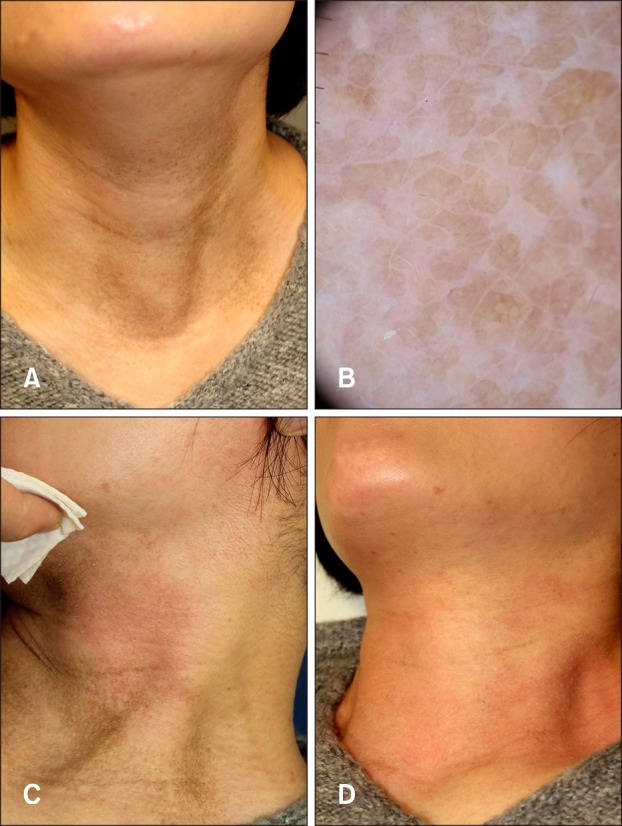Dear Editor:
Terra firma-forme dermatosis (TFFD) is an idiopathic benign skin disorder characterized by a dirty appearance of brownish pigmentation resulting from incomplete maturation of keratinocytes1. TFFD is thought to be prevalent in clinical practice, but it has been often ignored due to unawareness and indifference to the disease entity. Herein, we introduce a case of TFFD, which occurred on the anterior neck after robot-assisted thyroidectomy.
A 36-year-old woman was referred to our clinic with a 3-month history of an asymptomatic dirt-like brownish skin lesion on her anterior neck (Fig. 1A). Widely scattered tiny papules with fine crusts were observed; some of which were fused to form dark, velvety textured plaques. Despite normal daily cleansing to remove the lesion, it gradually expanded. The patient denied any discomfort such as pruritus. There were no previous medical problems apart from papillary thyroid carcinoma, which had been treated with robot-assisted total thyroidectomy 4 months prior. A KOH smear was negative. Dermoscopic examination showed multiple subtle brown polygons arranged in a tile-like pattern and each plat was separated by flesh-colored furrows (Fig. 1B). Based on the suspicion of TFFD, we attempted to rub the lesion firmly with alcohol swabs (Fig. 1C), exposing normal skin (Fig. 1D). There was no recurrence for a month.
TFFD is a bizarre condition which presents as dirt-like patches or plaques that are resistant to the usual cleansing method but resolved with alcohol swabs1. According to a report evaluating 11 cases of TFFD, almost two-third of the patients represented with TFFD at the surgical site post-operatively2. Surgical procedures related to TFFD included coronary bypass grafting, thyroidectomy, total knee replacement, and laparotomy for perforated duodenal ulcer. This suggests that TFFD can be manifested as a phenomenon associated with surgery. Altered sensation due to nerve injury following surgery can elicit fear and prevent patients from proper skin cleansing. In addition, applying several dressing materials such as povidone iodine may trigger an excessive accumulation of sweat and sebum on the surgical site2. Although our patient did not present with inappropriate washing habits, reluctance or hesitation to aggressive scrubbing may have been a contributing factor in the etiology of TFFD.
TFFD is easily misdiagnosed as it may clinically resemble other dermatological conditions. Dermatosis neglecta is the most challenging disease to be distinguished from TFFD3. It is more prevalent among patients with poor hygiene and is treated with standard cleansing, while TFFD patients usually have good hygiene and require vigorous alcohol rubs for restoration. Other differential diagnoses include confluent and reticulated papillomatosis, acanthosis nigricans and pityriasis versicolor3. Dermoscopy may aid the diagnosis of challenging cases and typically shows large pigmented polygonal areas with flat morphology arranged in a mosaic pattern in TFFD, which is consistent with our case4. On the other hand, poorly defined bordered, brownish pigmentation called a sulci and gyri pattern is visible in confluent and reticulated papillomatosis, focal dark brown spots on a yellowish background with aberrant crista cutis in acanthosis nigricans, and a pigmented scaly network consisting of brown bands in pityriasis versicolor5.
This is a case of TFFD which arose following thyroidectomy and successfully diagnosed based on the patient's history and dermoscopic findings. Awareness of its key dermoscopic features and its association with surgery is fundamental in the diagnosis of TFFD.
References
1. Moon J, Kim MW, Yoon HS, Cho S, Park HS. A case of terra firma-forme dermatosis: differentiation from other dirty-appearing diseases. Ann Dermatol. 2016; 28:413–415. PMID: 27274653.

2. Ashique KT, Kaliyadan F, Goyal T. Terra firma-forme dermatosis: report of a series of 11 cases and a brief review of the literature. Int J Dermatol. 2016; 55:769–774. PMID: 26474531.

3. Chun SW, Lee SY, Kim JB, Choi HM, Ro BI, Cho HK. A case of terra firma-forme dermatosis treated with salicylic acid alcohol peeling. Ann Dermatol. 2017; 29:83–85. PMID: 28223752.

4. Abdel-Razek MM, Fathy H. Terra firma-forme dermatosis: case series and dermoscopic features. Dermatol Online J. 2015; 21(10):20.

5. Zhou H, Tang XH, De Han J, Chen MK. Dermoscopy as an ancillary tool for the diagnosis of pityriasis versicolor. J Am Acad Dermatol. 2015; 73:e205–e206. PMID: 26568350.





 PDF
PDF ePub
ePub Citation
Citation Print
Print




 XML Download
XML Download